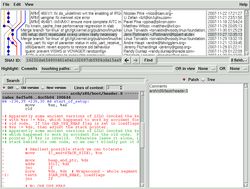Enrico Zini: apt-xapian-index now comes with a query tool
apt-xapian-index now comes with a query tool
I've just uploaded a new version of apt-xapian-index to unstable. Now it
comes with a little query tool called axi-cache.
You can search this way:
axi-cache search foo bar baz facet::tag sec:section
axi-cache more to get more results, or axi-cache again to
retry a search, or axi-cache again wibble wabble to add keywords to the
last search.
This allows to start with a search and tweak it. In order to work it needs to
save the last search so again or more can amend it. Searches are saved in
~/.cache/axi-cache.state.
You can search tags instead of packages by adding --tags.
It will suggest extra terms for the search, and also suggest extra tags.
It can even correct spelling mistakes in the query terms once the index has
been rebuilt with this new version of update-apt-xapian-index.
I need to thank Carl Worth who, with
notmuch, reminded me that if I just build a nice
interface on top of Xapian's query parser
I go quite a long way towards making a Xapian database
extremely useful indeed.
axi-cache also integrates with bash-completion so that tab completion is
context-sensitive to the command line being typed:
$ axi-cache search image pro
probability process processors programmability provides
problem processing production pronounced proving
$ axi-cache search kernel pro
problems processor production proved provided
processing processors programming provide provides
$ axi-cache help
Usage: axi-cache [options] command [args]
Query the Apt Xapian index.
Commands:
axi-cache help show a summary of commands
axi-cache search [terms] start a new search
axi-cache again [query] repeat the last search, possibly adding query terms
axi-cache more [count] show more terms from the last search
Options:
--version show program's version number and exit
-h, --help show this help message and exit
-s SORT, --sort=SORT sort by the given value, as listed in /var/lib/apt-
xapian-index/values
--tags show matching tags, rather than packages
--tabcomplete=TYPE suggest words for tab completion of the current
command line (type is 'plain' or 'partial')
update-apt-xapian-index as root before using axi-cache.
 I blogged a fair bit about
I blogged a fair bit about  … or something like that… I planned to write a short note about how to start with using git-svn so I can provide a pointer to some of my colleagues. It turned out that git has too many nice features that you should be aware of.
… or something like that… I planned to write a short note about how to start with using git-svn so I can provide a pointer to some of my colleagues. It turned out that git has too many nice features that you should be aware of. 
 Scott, I would have expected a little more from you than
Scott, I would have expected a little more from you than